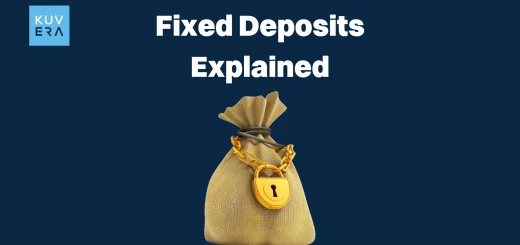Fixed deposits (FDs) are one of the favourite investment vehicles among investors with low risk tolerance. This is due to the fact that FDs are almost risk-free and deliver guaranteed interest income. Additionally, the interest rates are known in advance, so account holders are informed of the amount of interest they will accrue.
Suppose, for example, that a person has placed Rs. 5 lakhs in a fixed deposit account for three years. The annual interest rate on this deposit is 6.5%. The account holder would earn a total of Rs 6,90,210 in interest during the investment period. An online Kuvera’s FD interest calculator can calculate this sum in advance.
Due to the stability and security that fixed deposits provide, many conservative investors favour them over other high-risk investing options. There is a chance that even your parents or other relatives hold one or more fixed deposits.
As the legal successor, you should be informed of how to access the funds in the FD account in the event of the account holder’s demise. Depending on the kind of FD account, the individual eligible to make a claim and the method for obtaining the sum vary.
Holding Patterns And Nominees In A FD
When investing in Fixed Deposit account, you have the option of being the only account holder or opening the account jointly. For jointly held fixed deposits, the operational mandate must be selected. The most typical requirements are:
- Either Or Survivor: Only two individuals may open this account. Even if just one account holder signs the request, the financial institution will follow the instructions.
- Anyone or Survivor: This account may be opened by several users. Even if just one account holder signs the request, the financial institution will follow the instructions.
- Former or Survivor: Only the primary account holder may access and manage the account. The secondary account holder can only operate when the main account holder has passed away.
- Latter or Survivor: This account can only be accessed by the secondary account holder. The primary account holder can only operate when the secondary account holder has passed away.
- Joint: The account cannot be accessed until all account holders sign the request.
- Jointly or Survivor: Similar to Jointly, with the exception that the survivor can continue to run the account in the event that one account holder dies.
- Nominee: The nominee of a fixed deposit is the nominee. Consequently, he/she is the trustee of the FD and has control over it. In this essay, we shall examine fixed deposit nominee rights further.
Claiming FD After The Death Of The Account Holder
-
Individual Account
A nominee may or may not be designated by an individual account holder. Here is how both situations should be handled in the event that the account holder passes away.
When Nomination Is Available: The nominee may claim the FD maturity value by providing the account holder’s death certificate and their KYC records. The nominee must also provide the required forms of identification.
When There Is No Nomination: The legal heirs can submit the claim form, the account holder’s death certificate, and the succession certificate to get the FD value if the account holder neglected to name a nominee. A person who is legally entitled to inherit it in the event that the account holder passes away is known as a legal heir.
-
Joint Account
The FD value may be claimed in one of the two ways listed below depending on the circumstances following the death of the joint account holder.
Either Or Survivor Joint Account: After presenting the original account holder’s death certificate, the survivor can continue to use the FD account.
Jointly Or Survivor Account: After filing the death certificate of the Primary Account Holder, the Survivor may continue the FD account till maturity and take control of it.
Former Or Survivor Joint Account: Former refers to the main account holder. After filing the death certificate of the primary account holder, the survivor can take possession of the FD account.
Anyone Or Survivor Joint Account: In the event that the principal account holder passes away, the remaining members can continue to retain the primary position until the FD matures. If there are more than two account holders, the next member cannot make this change without the approval of every account holder.
Role Of Nominee In An Joint Account
The designation of a nominee on your FD account is vital in the event of unforeseen circumstances, but the solution is not absolute. Before beginning, you must have a clear understanding of the nominee’s function and rights to dispel any misunderstandings.
- A nominee serves as the custodian of the assets until the deposit proceeds are distributed to the true legal heirs.
- Therefore, the nominee is a trust beneficiary of the dead FD account and has no legal claim to the asset.
- When designated in a will, the nominee is able to exercise ownership of the asset.
- The nominee is the contact person in the event of the demise of the depositor before maturity.
- The nominee must be an individual.
- Societies, HUFs, and Trusts are unable to appoint nominees.
Premature FD Claims After The Death Of The Account Holder
If the survivors seek to collect the fixed deposit before the primary account holder dies, the process becomes significantly more complicated.
-
Individual Account
In the case of the death of the single holder of the FD, the legal heirs or the chosen nominee can request a premature withdrawal of the fixed deposit. To close the account, they will need to present documents such as the death certificate, their KYC certificates, and numerous other paperwork as needed by the financial institution. The timing of the early withdrawal may result in an interest loss.
-
Joint Account
The survivor could only request a premature FD withdrawal if all joint account holders authorised the withdrawal at the time the FD was opened. The majority of investors are unaware of the RBI circular establishing the 2015 provision. However, early withdrawal is permitted only with the consent of the survivor and the legal heirs of the dead main holder. If there are no surviving beneficiaries, the nominee might file for premature withdrawal after meeting the conditions. In the absence of a nominee, the legal heirs can file a claim for premature FD closure, subject to regulations compliance.
Documents Required For Fixed Deposit Claims After Death
Proper paperwork is necessary for a smooth account settlement following the demise of the account holder.
When A Nomination Is Present
- Claim form
- Death certificate of the account holder issued by the local authority
- Photo ID, proof of address, and other Know Your Customer (KYC) documentation of the candidate
When No Nomination Is Available
- Claim form
- Local authority death certificate of the account holder
- Succession certificate
It is essential to understand how funds can be claimed in the account holder’s absence. This helps prevent future inconveniences. In the absence of the account holder, it is prudent to guarantee that the money is sent to the proper recipient.
Steps For Filing A Death Claim For A Solo Account Holder:
Step 1: Collect a ‘Claim form’ at bank branch and carefully fill out all of the input boxes.
Step 2: Attach your photos as well as the accompanying papers to the completed form:
- Chequebook, passbook, deceased’s ATM card, death certificate, nomination receipt
- Valid address proof of the nominee and, most significantly, identification proof of the candidate declaring the deceased’s relationship
Step 3: After presenting these papers, a nominee must obtain the signatures of two witnesses.
Step 4: Finally, upon successful verification, Bank may begin the transfer of the claimed amount to the nominee’s account.
Steps To Take To Claim Money If The Deceased’s Account Is Held Jointly With The Survivorship Clause.
If the deceased’s account was held jointly but without a registered nomination, the process of making a death claim is rather simple. Before submitting a death claim, a claimant must verify that they have all necessary documentation.
Step 1: Inform the bank of the account holder’s death by submitting a formal application.
Step 2: Include a photocopy of the dead account holder’s death certificate and valid ID evidence (self-attested by the surviving account holder) with the written application.
Step 3: Submit a properly completed new account opening form.
Step 4: You will also be required to submit a copy of your identity evidence, such as an Aadhaar card, PAN card, passport, or driving licence. Produce them, as well as a current image, and attach them to the form.
Step 5: Following submission, the bank will initiate the process of transferring funds to the remaining account holder. Throughout the proceedings, the bank sends SMS to keep the claimant informed.
Note:
In addition to the above mentioned options, there exists a type known as a “Minor Account.” If the primary account holder is younger than 18 years old, an adult guardian can be added as a joint account holder. Important to note: If the mode of service is “either or survivor” or “jointly,” all existing account holders must sign the application form. Deposit accounts under which a valid nomination is available and opened under the survivor provision, i.e. either or survivor or former or survivor or anyone or survivor or latter of survivor; the payment to the survivor(s)/nominee of the deposit account is a valid release of the liability of the bank provided once it has been adequately looked after, and cautioned in the deposit account.
These bank payments to the survivor(s)/nominee have no bearing on any claim or right against the survivors. The legal representation/succession certificate/letter of administration or probate, etc., should not be relied upon by banks.
In the case of accounts without the survivor/nominee provision, banks may establish a minimum balance threshold in the dead account for claims to be paid, without needing any papers other than the indemnification letter. Regarding the locker holder’s/demise, depositor’s banks may use the same procedure as for deposit accounts in order to access the contents of the locker/safe custody article. Repayment of claims and distribution payments to survivors / nominees are permitted by banks for payment within 15 days of the day the claim is received, pending verification of the depositor’s demise and acceptable acknowledgment of the claim (s).
In the case of missing persons, claims may be asserted on the basis of presumption of death, which may be asserted only after seven years have passed since the person was declared missing to a competent court and the court presumes the individual is deceased pursuant to Section 107/108 of the Indian Evidence Act, 1872. By creating a threshold cap, banks can formulate a strategy to resolve claims for missing persons without requiring the production of papers other than the FIR, the traceable report by police agencies, and an indemnification letter.
Conclusion
The FD is a fantastic investment option due to its security and increased yields. However, you must plan for unfortunate occurrences that may cause your loved ones inconvenience in your absence. The easiest method is to nominate a nominee in the FD account, whether the account is single or joint. In addition, it is prudent to inform your family members of the processes in advance to minimise future complications with claim settlement.
FAQs
-
Who Is The Nominee?
A nominee is a person designated by the account holder to receive the bank account balance upon the account holder’s death. Therefore, following the account holder’s death, the nominee can notify the bank, produce the necessary papers (ID evidence of the nominee and the account holder’s death certificate), withdraw the cash, and cancel the account.
-
Is It Necessary To Nominate A Nominee When Creating An FD account?
It is not mandatory to choose a nominee. However, it is recommended that a nominee be named so that the money may be readily transferred to the person who is legally entitled to receive it in the event of the account holder’s death.
-
Can The Nominated Continue FD After His Or Her Death?</h4
Yes, if the account holder dies, his or her nominee may continue the FD.
-
Is It Possible To Add More Than One Nominee To The FD Account?
You cannot name more than one candidate for an FD account, whether it is owned singly or jointly. You can, however, choose different candidates for your several FD accounts.
Interested in how we think about the markets?
Read more: Zen And The Art Of Investing
Check out all our “Investor Education Originals” videos on Youtube and get smart about investing.
Start investing through a platform that brings goal planning and investing to your fingertips. Visit kuvera.in to discover Direct Plans and Fixed Deposits and start investing today.
#MutualFundSahiHai #KuveraSabseSahiHai #PersonalFinance #InvestorEducation;











